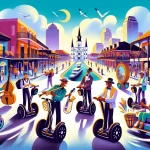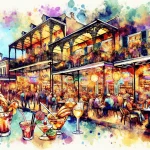New Orleans, famed for its captivating culture, rich history, and distinctive architecture, is best explored on foot. Walking tours have gained immense popularity among visitors seeking to fully immerse themselves in the city’s alluring ambiance.
In This Article
TL;DR
- Walking tours allow visitors to intimately experience New Orleans’ unique atmosphere, a culturally significant exploration method.
- A variety of walking tours are available, focusing on history, architecture, local cuisine, and even haunted narratives.
- Exploring New Orleans by foot provides an immersive and personal experience, enabling visitors to uncover hidden gems with knowledgeable local guides.
Types of Walking Tours in New Orleans
Historical Tours: Explore the French Quarter and its Rich History
The French Quarter, the oldest neighborhood in New Orleans, is a must-see for history enthusiasts. Walking tours of this iconic area delve into the city’s colonial past, showcasing landmarks such as Jackson Square, St. Louis Cathedral, and the Cabildo. Knowledgeable guides share fascinating stories about the city’s founding, its Spanish and French influences, and the significant events that shaped its development.
Ghost Tours: Delve into the Haunted Tales of the City
New Orleans is known for its haunted history, and ghost tours are a popular way to explore the city’s supernatural side. These tours often take place at night, adding to the eerie atmosphere. Visitors can explore famous haunted locations like the LaLaurie Mansion and Hotel Monteleone while listening to spine-chilling tales of ghostly encounters and local legends.
Culinary Tours: Experience the Unique Flavors of New Orleans Cuisine
New Orleans is a food lover’s paradise, and culinary walking tours offer a delicious way to sample the city’s iconic dishes. From beignets and gumbo to po’boys and jambalaya, these tours take visitors on a gastronomic journey through the city’s best eateries. Along the way, guides share insights into the historical and cultural influences that have shaped New Orleans’ distinctive cuisine.
Planning Your Walking Tour
Best Times to Go: Weather Considerations and Seasonal Events
The best time to take a walking tour in New Orleans depends on your preferences and tolerance for weather conditions. The city experiences hot and humid summers, with temperatures often reaching the 90s°F (32-37°C). Spring and fall offer milder temperatures and are popular times for walking tours. Keep in mind that New Orleans hosts many festivals throughout the year, such as Mardi Gras and Jazz Fest, which can affect tour availability and crowd levels.
What to Bring: Essentials for Comfort and Convenience
To ensure a comfortable walking tour experience, it’s essential to come prepared. Wear comfortable, closed-toe shoes suitable for walking on uneven surfaces. Bring a refillable water bottle to stay hydrated, especially during the hotter months. Don’t forget to apply sunscreen and wear a hat or sunglasses for sun protection. A small backpack or crossbody bag is handy for carrying essentials like a camera, snacks, and a light jacket for cooler evenings.
Booking Tours: Tips on Selecting and Reserving Your Spot
When booking a walking tour, consider your interests and the tour’s focus. Read reviews from previous participants to gauge the quality of the tour and the guide’s expertise. Book your tour in advance, especially during peak travel seasons, to ensure availability. Many tour companies offer online booking, making it convenient to reserve your spot. Be sure to note the meeting location and arrive promptly to avoid missing the tour.
Historical Walking Tours
Key Landmarks: St. Louis Cathedral, Jackson Square, and the Cabildo
Historical walking tours in New Orleans often focus on the French Quarter’s iconic landmarks. St. Louis Cathedral, the oldest continuously active cathedral in the United States, is a stunning example of Spanish colonial architecture. Jackson Square, originally known as Place d’Armes, has been the heart of the city since the 18th century. The Cabildo, a former Spanish government building, now serves as a museum showcasing the city’s history.
Stories and Significance: Insights into the Historical Events that Shaped the City
Walking tours provide a unique opportunity to learn about the historical events that have shaped New Orleans. Guides share captivating stories about the city’s founding by French colonists in 1718, its brief period under Spanish rule, and its eventual acquisition by the United States as part of the Louisiana Purchase in 1803. Visitors also learn about the city’s role in the Civil War, its devastating experience during Hurricane Katrina, and its resilient spirit in the face of adversity.
Expert Guides: The Role of Knowledgeable Guides in Enhancing the Tour Experience
One of the highlights of historical walking tours in New Orleans is the expertise of the guides. Many guides are local historians or have a deep passion for the city’s history. They bring the past to life through engaging storytelling, sharing anecdotes and lesser-known facts that visitors might not find in guidebooks. Their knowledge and enthusiasm enhance the tour experience, making it both educational and entertaining.
Ghost Tours
Famous Haunted Locations: LaLaurie Mansion and Hotel Monteleone
New Orleans is known for its haunted history, and ghost tours take visitors to some of the city’s most notorious haunted locations. The LaLaurie Mansion, a beautiful antebellum home in the French Quarter, is infamous for its dark past involving the torture and mistreatment of enslaved people by its former owner, Madame Delphine LaLaurie. Hotel Monteleone, a luxurious hotel in the heart of the French Quarter, is said to be haunted by the spirits of former guests and employees.
Thematic Stories: Connections to Local Legends and Folklore
Ghost tours in New Orleans often weave together local legends and folklore to create a chilling narrative. Guides share stories of voodoo queens, vengeful spirits, and tragic tales of love and loss. These thematic stories add depth to the haunted locations visited and provide insight into the city’s rich tapestry of supernatural beliefs and traditions.
Nighttime Settings: The Atmosphere of New Orleans After Dark
Many ghost tours take place at night, adding to the eerie atmosphere of the experience. As visitors walk through the dimly lit streets of the French Quarter, the city takes on a different character. The flickering gas lamps, the sound of distant jazz music, and the occasional creaking of old buildings create a spine-tingling ambiance that enhances the ghostly tales shared by the guides.
Culinary Walking Tours
Sampling Local Dishes: Beignets, Gumbo, and Po’boys
Culinary walking tours in New Orleans offer a delicious way to explore the city’s iconic dishes. Visitors have the opportunity to sample classic New Orleans fare such as beignets, the famous square doughnuts dusted with powdered sugar, at Café du Monde. They can also taste the rich, flavorful gumbo, a stew-like dish that combines various meats or seafood with a dark roux, vegetables, and Creole seasonings. Po’boys, the city’s signature sandwich, are another must-try, featuring crispy French bread filled with fried seafood or roast beef.
Visits to Iconic Eateries: Café du Monde and Antoine’s
Culinary tours often include stops at some of New Orleans’ most iconic eateries. Café du Monde, established in 1862, is a beloved institution known for its beignets and chicory-blended coffee. Antoine’s, founded in 1840, is the oldest continuously operating restaurant in the United States and is famous for its classic Creole dishes such as Oysters Rockefeller and Pompano en Papillote.
Insights into Creole and Cajun Cooking: Historical and Cultural Influences
During culinary walking tours, guides provide insights into the historical and cultural influences that have shaped New Orleans’ distinctive cuisine. Visitors learn about the differences between Creole and Cajun cooking, which have roots in the city’s French, Spanish, African, and Native American heritage. Guides also share stories about the evolution of iconic dishes and the role of food in the city’s social and cultural traditions.
Architectural Tours
Distinctive Styles: Creole Townhouses, Shotgun Homes, and Antebellum Mansions
New Orleans is renowned for its unique architecture, which reflects the city’s diverse cultural influences. Architectural walking tours showcase the distinctive styles found throughout the city. In the French Quarter, visitors can admire the elegant Creole townhouses with their wrought-iron balconies and lush courtyards. Shotgun homes, narrow houses with rooms arranged one behind the other, are a common sight in neighborhoods like the Marigny and Bywater. The Garden District is famous for its grand antebellum mansions, which feature Greek Revival and Italianate styles.
Neighborhood Focus: French Quarter, Garden District, and Marigny
Architectural tours often focus on specific neighborhoods to provide a deeper understanding of the city’s architectural heritage. The French Quarter, with its Spanish colonial and Creole influences, is a prime example of the city’s early architectural styles. The Garden District, developed in the 19th century, showcases the opulent mansions built by wealthy Americans who settled in New Orleans. The Marigny, a historic neighborhood adjacent to the French Quarter, features a mix of Creole cottages and shotgun homes, reflecting the area’s working-class roots.
Preservation Efforts: The Role of Architecture in City Identity
New Orleans takes great pride in its architectural heritage, and preservation efforts play a crucial role in maintaining the city’s unique character. Architectural tours often highlight the importance of historic preservation and the challenges faced in protecting the city’s built environment. Guides share stories about successful restoration projects, such as the revitalization of the Cabildo and the Presbytère, and discuss the ongoing efforts to preserve the city’s architectural treasures for future generations.
Enhancing Your Tour Experience
Interactive Elements: Participation in Local Traditions and Customs
Many walking tours in New Orleans incorporate interactive elements that allow visitors to participate in local traditions and customs. For example, some culinary tours may include a hands-on cooking demonstration or a cocktail-making class. Ghost tours may encourage visitors to use ghost-hunting equipment or participate in a séance. These interactive experiences add a fun and engaging dimension to the tour, making it more memorable for participants.
Photography Tips: Best Spots and Techniques for Capturing the City’s Charm
New Orleans is a photographer’s dream, with its picturesque architecture, vibrant street scenes, and unique cultural elements. Walking tour guides often share tips on the best spots to capture stunning photos and offer advice on techniques to make the most of lighting and composition. They may point out hidden gems or provide access to exclusive vantage points that offer breathtaking views of the city.
Souvenirs: Where to Find Authentic Local Crafts and Artworks
Walking tours often include stops at local shops and galleries where visitors can purchase authentic New Orleans souvenirs. Guides may recommend places to find handcrafted Mardi Gras masks, locally made jewelry, or original artworks by New Orleans artists. By supporting these local businesses, visitors can take home a piece of the city’s creative spirit and contribute to the local economy.
Safety and Accessibility
Navigating the Streets: Advice on Safety and Mobility in Historic Areas
New Orleans’ historic neighborhoods, with their uneven sidewalks and narrow streets, can present challenges for some visitors. Walking tour guides provide advice on navigating these areas safely, pointing out potential hazards and offering tips on mobility. They may suggest alternative routes or accommodations for those with mobility concerns, ensuring that everyone can enjoy the tour comfortably.
Accessibility Information: Options for Those with Mobility Challenges
Many walking tour companies in New Orleans strive to make their tours accessible to all visitors. They may offer tours that are specifically designed for those with mobility challenges, such as wheelchair-accessible routes or tours with frequent rest stops. Some companies may also provide assistive devices, such as portable seating or audio amplification, to enhance the tour experience for those who need them.
Local Support Services: Contact Information for Tour Assistance and Emergencies
Walking tour guides are knowledgeable about local support services and can provide contact information for assistance during the tour or in case of emergencies. They may have a list of nearby restrooms, water fountains, and places to rest or cool off during hot weather. In the event of a medical emergency, guides are trained to contact local authorities and provide basic first aid until help arrives.
New Orleans’ walking tours offer a fascinating and immersive way to explore the city’s rich history, vibrant culture, and unique architecture. Whether you’re interested in learning about the city’s colonial past, sampling its delicious cuisine, or delving into its haunted tales, there’s a walking tour to suit every interest. By joining a tour led by knowledgeable local guides, visitors can gain a deeper appreciation for the city’s heritage and experience the Big Easy like a true insider.






